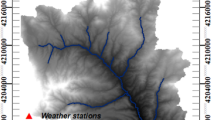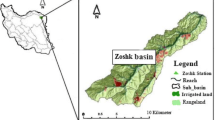Abstract
Soil and Water Assessment Tool (SWAT) is a river basin scale model widely used to study the impact of land management practices in large, complex watersheds. Even though model output uncertainties are generally recognized to affect watershed management decisions, those uncertainties are largely ignored in model applications. The uncertainties of SWAT simulations are quantified using various methods, but simultaneous attempt to calibrate a model so as to reduce the uncertainty are seldom done. This study aims to use an uncertainty reduction procedure that helps calibrate the SWAT model. The shuffled complex evolutionary metropolis algorithm for uncertainty analysis is employed for this purpose, and is demonstrated using the data from the St. Joseph River basin, USA. The values of the performance indices, the r2 and the Nash–Sutcliffe efficiency (NSE) for the simulations during calibration period was found to be 0.81 (same for r2 and NSE) and 0.79 for validation period indicating a good simulation by the model. The results also indicate that the algorithm helps reduce the uncertainty (percentage of coverage = 62% and average width = 19.2 m3/s), and also identifies the plausible range of parameters that simulate the processes with less uncertainty. The confidence bands of simulations are obtained that can be employed in making uncertainty-based decisions on watershed management practices.










Similar content being viewed by others
References
Abbaspour KC, Vejdani M, Haghighat S, Yang J (2007) SWAT-CUP calibration and uncertainty programs for SWAT. In: Oxley L, Kulasiri D (eds) MODSIM 2007 international congress on modelling and simulation. Modelling and Simulation Society of Australia and New Zealand, Melbourne, pp 1596–1602
Abbaspour KC, Rouholahnejada E, Vaghefia S, Srinivasan R, Yang H, Kløve B (2015) A continental-scale hydrology and water quality model for Europe: calibration and uncertainty of a high-resolution large-scale SWAT model. J Hydrol 524:733–752
Alvisi S, Franchini M (2011) Fuzzy neural networks for water level and discharge forecasting with uncertainty. Environ Model Softw 26(4):523–537
Arabi M, Govindaraju RS, Engel B, Hantush M (2007) Multiobjective sensitivity analysis of sediment and nutrient processes with a watershed model. Water Resour Res 43:W06409
Arnold JG, Moriasi DN, Gassman PW, Abbaspour KC, White MJ, Srinivasan R, Santhi C, Harmel RD, Van Griensven A, Van Liew MW, Kannan N, Jha MK (2012) SWAT: model use, calibration, and validation. Trans ASABE 55(4):1491–1508
Athira P, Sudheer KP (2015) A method to reduce the computational requirement while assessing uncertainty of complex hydrological models. Stoch Environ Res Risk Assess 29(3):847–859
Beven K (2006) A manifesto for the equifinality thesis. J Hydrol 320(1–2):18–36
Beven K, Binley A (1992) The future of distributed models: model calibration and uncertainty prediction. Hydrol Process 6:279–298
Beven KJ, Freer J, Hankin B, Schulz K (2000) The use of generalized likelihood measures for uncertainty estimation in higher-order models of environmental systems. In: Fitzgerald Smith RC, Walden AT, Young PC (eds) Nonlinear and nonstationary signal processing. Cambridge University Press, Cambridge
Box GEP, Tiao GC (1973) Bayesian inference in statistical analysis. Addison-Wesley Publishing Company, Boston, pp 10–20
Boyle DP, Gupta HV, Sorooshian S (2000) Toward improved calibration of hydrologic models: combining the strengths of manual and automatic methods. Water Resour Res 36(12):3663–3674
Brazier RE, Beven K, Freer J, Rowan JS (2000) Equifinality and uncertainty in physically based soil erosion models: application of the GLUE methodology to WEPP—the Water Erosion Prediction Project—for sites in the UK and USA. Earth Surf Proc Landf 25(8):825–845
Cibin R (2013) Optimal Land Use Planning on Selection and Placement of Energy Crops for Sustainable Biofuel Production (Ph.D. dissertation). In: Department of Agricultural and Biological Engineering, Purdue University, ProQuest, UMI Dissertations Publishing
Cibin R, Chaubey I (2015) A computationally efficient approach for watershed scale spatial optimization. Environ Model Softw 66:1–11
Cibin R, Sudheer KP, Chaubey I (2010) Sensitivity and identifiability of stream flow generation parameters of the SWAT model. Hydrol Process 24(9):1133–1148
Cibin R, Trybula E, Chaubey I, Brouder SM, Volenec JJ (2016) Watershed-scale impacts of bioenergy crops on hydrology and water quality using improved SWAT model. GCB Bioenergy 8:837–848
Devia GK, Ganasri BP, Dwarakish GS (2015) A review on hydrological models. Aquat Proc 4:1001–1007
Duan Q, Sorooshian S, Gupta V (1992) Effective and efficient global optimization for conceptual rainfall-runoff models. Water Resour Res 28(4):1015–1031
Duru U (2015) Modeling sediment yield and deposition using the swat model: a case study of Cubuk I and Cubuk II reservoirs, Turkey (Doctoral dissertation, Colorado State University. Libraries)
Engel B, Storm D, White M, Arnold J, Arabi M (2007) A hydrologic/water quality model application. J Am Water Resour Assoc 43(5):1223–1236
Femeena PV (2013) Spatial optimization of cropping pattern in an agricultural watershed for food and biofuel production with minimum downstream pollution (Master thesis). Department of Civil Engineering, Indian Institute of Technology Madras, Chennai
Feyen L, Vrugt JA, Nualláin B, Van Der Knijff J, De Roo A (2007) Parameter optimization and uncertainty assessment for large-scale stream flow simulation with the LISFLOOD model. J Hydrol 332(3):276–289
Fukunaga DC, Cecílio RA, Zanetti SS, Oliveira LT, Caiado MAC (2015) Application of the SWAT hydrologic model to a tropical watershed at Brazil. Catena 125:206–213
Gassman PW, Williams JR, Wang X, Saleh A, Osei E, Hauck LM, Izaurralde RC, Flowers JD (2010) The agricultural policy environmental extender (APEX) model: an emerging tool for landscape and watershed environmental analyses. Trans ASABE 53(3):711–740
Gelman A, Roberts G, Gilks W (1996) Efficient metropolis jumping rules. Bayesian Stat 42:599–608
Green CH, Van Griensven A (2008) Auto calibration in hydrologic modeling: using SWAT2005 in small-scale watersheds. Environ Model Softw 23(4):422–434
Gupta HV, Sorooshian S, Yapo PO (1998) Towards improved calibration of hydrologic models: multiple and no commensurable measures of information. Water Resour Res 34(4):751–763
Hasan MA, Pradhanang SM (2017) Estimation of flow regime for a spatially varied Himalayan watershed using improved multi-site calibration of the Soil and Water Assessment Tool (SWAT) model. Environ Earth Sci 76:787. https://doi.org/10.1007/s12665-017-7134-3
Heathman GC, Flanagan DC, Larose M, Zuercher BW (2008) Application of the Soil and Water Assessment Tool and annualized agricultural non-point source models in the St. Joseph River watershed. J Soil Water Conserv 63(6):552–568
Her Y, Cibin R, Chaubey I (2015) Application of parallel computing methods for improving efficiency of optimization in hydrologic and water quality modeling. Appl Eng Agric 31(3):455–468
Jha MK, Gassman PW, Arnold JG (2007) Water quality modeling for the Raccoon River watershed using SWAT. Trans ASABE 50(2):479–493
Kasiviswanathan KS, Sudheer KP (2013) Quantification of the predictive uncertainty of artificial neural network based river flow forecast models. Stoch Environ Res Risk Assess 27(1):137–146
Kasiviswanathan KS, Sudheer KP (2014) Discussion of comparison of three global optimization algorithms for calibration of the Xinanjiang model parameters by Dong-mei Xu, Wen-chuan Wang, Kwok-wing Chau, Chun-tian Cheng and Shou-yu, 2013. J Hydroinform 15(1):174–193. https://doi.org/10.2166/hydro.2012.053 (Journal of Hydroinformatics 16(6):1461–1463)
Kuczera G, Mroczkowski M (1998) Assessment of hydrologic parameter uncertainty and the worth of multiresponse data. Water Resour Res. https://doi.org/10.1029/98WR00496 (ISSN: 0043–1397)
Kuczera G, Parent E (1998) Monte Carlo assessment of parameter uncertainty in conceptual catchment models: the Metropolis algorithm. J Hydrol 211(1):69–85
Maringanti C, Chaubey I, Arabi M, Engel B (2011) Application of a multiobjective optimization method to provide least cost alternatives for NPS pollution control. Environ Manag. https://doi.org/10.1007/s00267-011-9696-2:448-461
McKay MD, Beckman RJ, Conover WJ (1979) Comparison of three methods for selecting values of input variables in the analysis of output from a computer code. Technometrics 21(2):239–245
Metropolis N, Rosenbluth AW, Rosenbluth MN, Teller AH, Teller E (1953) Equation of state calculations by fast computing machines. J Chem Phys 21(6):1087–1092
Misirli F, Gupta HV, Sorooshian S, Thiemann M (2003) Bayesian recursive estimation of parameter and output uncertainty for watershed models. In: Duan Q et al (eds) Calibration of watershed models, Water science and application, vol 6. AGU, Washington, D. C., pp 113–124
Moriasi DN, Arnold JG, Van Liew MW, Bingner RL, Harmel RD, Veith TL (2007) Model evaluation guidelines for systematic quantification of accuracy in watershed simulations. Trans ASABE 50(3):885–900
Nash JE, Sutcliffe JV (1970) River flow forecasting through conceptual models part I—a discussion of principles. J Hydrol 10(3):282–290
Pluntke T, Pavlik D, Bernhofer C (2014) Reducing uncertainty in hydrological modelling in a data sparse region. Environ Earth Sci 72:4801. https://doi.org/10.1007/s12665-014-3252-3
Roth V, Nigussie TK, Lemann T (2016) Model parameter transfer for streamflow and sediment loss prediction with SWAT in a tropical watershed. Environ Earth Sci 75:1321. https://doi.org/10.1007/s12665-016-6129-9
Runkel RL, Crawford CG, Cohn TA (2004) Load estimator (LOADEST)—A FORTRAN program for estimating constituent loads in streams and rivers, Techniques and methods, Chapter A5. US Geological Survey, Reston, Virginia
Schaap MG, Feike JL (1998) Using neural networks to predict soil water retention and soil hydraulic conductivity. Soil Tillage Res 47(1):37–42
Shen ZY, Chen L, Chen T (2012) Analysis of parameter uncertainty in hydrological and sediment modeling using GLUE method: a case study of SWAT model applied to three gorges reservoir region, China. Hydrol Earth Syst Sci 16:121–132. https://doi.org/10.5194/hess-16-121-2012
Singh VP (1995) Watershed modeling. In: Singh VP (ed) Computer models of watershed hydrology. Water Resources Publications, Littleton, pp 1–22
Song L, Liu P (2010) Study of agricultural non-point source pollution based on SWAT. Adv Mater Res 113–114:390–394
Srivastava PK, Han D, Rico-Ramirez MA, Islam T (2013) Sensitivity and uncertainty analysis of mesoscale model downscaled hydro-meteorological variables for discharge prediction. Hydrol Process. https://doi.org/10.1002/hyp.9946
Sudheer KP, Chaubey I, Garg V, Migliaccio KW (2007) Impact of time-scale of the calibration objective function on the performance of watershed models. Hydrol Process 21(25):3409–3419
Sudheer KP, Lakshmi G, Chaubey I (2011) Application of a pseudo simulator to evaluate the sensitivity of parameters in complex watershed models. Environ Model Softw 26(2):135–143
Tarantola A (2005) Inverse problem theory and methods for model parameter estimation. Society for Industrial and Applied Mathematics, Philadelphia, pp 41–51
Vazquez-Amabile G, Engel BA, Flanagan DC (2006) Modeling and risk analysis of nonpoint source pollution caused by atrazine using SWAT. Trans ASABE 49(3):667–678
Vrugt JA, Bouten W, Gupta HV, Sorooshian S (2002) Toward improved identifiability of hydrologic model parameters: the information content of experimental data. Water Resour Res 38(12):48–51
Vrugt JA, Gupta HV, Bastidas LA, Bouten W, Sorooshian S (2003) Effective and efficient algorithm for multiobjective optimization of hydrologic models. Water Resour Res. https://doi.org/10.1029/2002WR001746 (ISSN: 0043–1397)
Worku T, Khare D, Tripathi SK (2017) Modeling runoff-sediment response to land use/land cover changes using integrated GIS and SWAT model in the Beressa watershed. Environ Earth Sci 76:550. https://doi.org/10.1007/s12665-017-6883-3
Wu H, Chen B (2015) Evaluating uncertainty estimates in distributed hydrological modeling for the Wenjing River watershed in China by GLUE, SUFI-2, and ParaSol methods. Ecol Eng 76:110–121
Yang J, Reichert P, Abbaspour K, Xia J, Yang H (2008) Comparing uncertainty analysis techniques for a SWAT application to the Chaohe Basin in China. J Hydrol 358:1–23
Yesuf HM, Melesse AM, Zeleke G, Alamirew T (2016) Streamflow prediction uncertainty analysis and verification of SWAT model in a tropical watershed. Environ Earth Sci 75:806. https://doi.org/10.1007/s12665-016-5636-z
Zhang X, Srinivasan R, Liew M Van (2008) Multi-Site calibration of the SWAT model for hydrologic modeling. Trans ASABE 51(6):2039–2049
Zhang X, Srinivasan R, Bosch D (2009a) Calibration and uncertainty analysis of the SWAT model using genetic algorithms and bayesian model averaging. J Hydrol 374(3–4):307–317. https://doi.org/10.1016/j.jhydrol.2009.06.023
Zhang X, Srinivasan R, Kaiguang Z, Liew M Van (2009b) Evaluation of global optimization algorithms for parameter calibration of a computationally intensive hydrologic model. Hydrol Process 23(3):430–441
Author information
Authors and Affiliations
Corresponding author
Rights and permissions
About this article
Cite this article
Krishnan, N., Raj, C., Chaubey, I. et al. Parameter estimation of SWAT and quantification of consequent confidence bands of model simulations. Environ Earth Sci 77, 470 (2018). https://doi.org/10.1007/s12665-018-7619-8
Received:
Accepted:
Published:
DOI: https://doi.org/10.1007/s12665-018-7619-8




